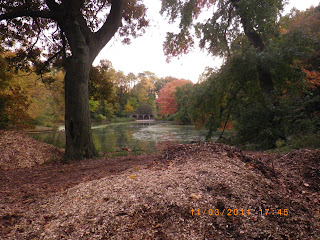
Well, the season is just about finished as the
temperatures get lower and lower. My goal
for the month was to catch at least one carp
before the lakes become iced over.

I chose Wagner's Cove, a secluded cove on the
main lake in Central Park. It is named for the
former Mayor of New York City, Robert F. Wagner Jr.
who was the son of United States Senator Robert F. Wagner .
I began chumming this spot with various ground
baits to attract carp to this area.

I caught my first carp of December the next
afternoon as the temperature reached 60F.
I chummed the cove a second day. Before I
left I had hooked my second carp in 3 days.

By the fourth day, I had told Dennis of my
success. We arrived at the park early, 9:30 AM.
I set up but we had no bites so we took the train
up to The Meer at 110th street. We fished there
until about 2:00 PM & then took a ride back down
to 72nd street & "The Cove".

From past experience I knew the carp would
be active after three o'clock.
We saw bubbles coming to the surface of the
water, which can indicate that carp are actively
feeding; or it could just be gas escaping from
rotting vegetable matter laying on the lake bottom.

Looking north at Wagner's Cove.

Winter red

Near the Bethesda fountain, a prime area
for surface feeding carp during warm weather.

Pictured is my fourth carp for December. This
fellow was almost 10 pounds. I used my Fenwick
7 wt fiberglass fly rod.





















